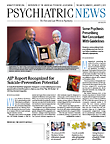Antipsychotic prescribing for nearly 40 percent of patients with first-episode psychosis was not concordant with practice guidelines, according to the report “Prescription Practices in the Treatment of First-Episode Schizophrenia Spectrum Disorders: Data From the National RAISE-ETP Study.” The study was published online in AJP in Advance on December 4, 2014.
Practice guidelines with specific first-episode recommendations and first-episode research data support the need for low-dose, antipsychotic monotherapy and the need to minimize side effects, especially metabolic ones, during early-phase treatment.
But Delbert Robinson, M.D., of the research department at Zucker Hillside Hospital, and colleagues found prescribing patterns did not abide by guidelines for 159 of 404 first-episode patients at community treatment centers in 21 states. The most common practices that were not concordant with guidelines were use of more than one antipsychotic drug, use of a higher-than-recommended antipsychotic dosage, use of a psychotropic medication other than an antipsychotic, use of an antidepressant without justification, and/or use of olanzapine, an antipsychotic that is especially likely to cause significant weight gain but was often prescribed at high dosages nonetheless.
“Although each questionable medication practice we identified affected only 1.2 percent to 4.4 percent of patients, cumulatively 39.4 percent of patients might have benefited from changes in their psychotropic medication prescriptions,” Robinson and colleagues suggested. “Primary immediate targets for improving first-episode community treatment include discouraging the use of two or more antipsychotics and the prescription of olanzapine, especially at high dosages.”
In the study, prescription data were obtained at study entry from 404 participants in the Recovery After an Initial Schizophrenia Episode Project’s Early Treatment Program (RAISE-ETP), a nationwide multisite effectiveness study for patients with first-episode schizophrenia spectrum disorders. That study had provided the basis for the first national report of U.S. community mental health center medication treatments for the crucial early phase of schizophrenia.
In the present study, Robinson and colleagues addressed two questions: What are the medication treatments currently used in community settings? What factors are associated with choice of medication strategy?
They employed site randomization to facilitate participation by sites without previous research experience to eliminate potential treatment strategy “spillover” effects and to enhance study acceptability by patients, who would not need to agree to individual randomization. Thirty-four sites in 21 states were selected after a national search. All were community treatment centers with no preexisting first-episode program. The RAISE-ETP data analyzed in this study were collected between July 2010 and July 2012.
In comments to Psychiatric News, Robinson said research findings have elucidated the differences between optimal treatment requirements for first-episode versus multi-episode schizophrenia.
“The challenge for the field is to get this specialized knowledge to busy clinicians,” he said. “General education about first-episode treatment is one method. Our study also found some targets for potential focused education efforts. For example, a large number of patients were receiving antidepressant prescriptions without a clear indication for their use, and the antipsychotic olanzapine was often used at high doses. Policymakers may also need to consider service delivery factors given our findings about the effects of insurance status on prescription.”
For instance, statistical analysis showed evidence for sex, age, and insurance status effects on prescription practices. In particular, patients who were privately insured were more likely to receive an antipsychotic than those with public insurance or no insurance and were more than 50 percent more likely to receive monotherapy (rather than polytherapy).
Robinson and colleagues noted that since the incidence of schizophrenia is low, most clinicians’ experience outside of specialty centers is heavily weighted toward the treatment of multi-episode patients. And the results of the new study indicate a need for education of clinicians about the specialized recommendations for first-episode patients.
At the same time, however, studies have shown that aggressive treatment of first-episode psychosis is crucial to the long-term trajectory of illness and outcome. American Journal of Psychiatry Editor Robert Freedman, M.D., told Psychiatric News that some of the prescribing practices identified in the study may not necessarily be clinically inappropriate.
“The prescription of higher doses of antipsychotics, and specifically olanzapine, to first-episode patients is outside guidelines, but whether or not it is misinformed clinical practice has yet to be determined,” he said. “First-episode patients are often identified by their families and clinicians because they have suddenly become acutely psychotic, and it is often necessary, for both clinical and financial reasons, to decrease their symptoms as quickly as possible.”
He added that future analyses of the data “may help clarify the reason for these prescription strategies and their utility and thus will ultimately inform guidelines.” ■
“Prescription Practices in the Treatment of First-Episode Schizophrenia Spectrum Disorders: Data From the National RAISE-ETP Study” can be accessed
here.
